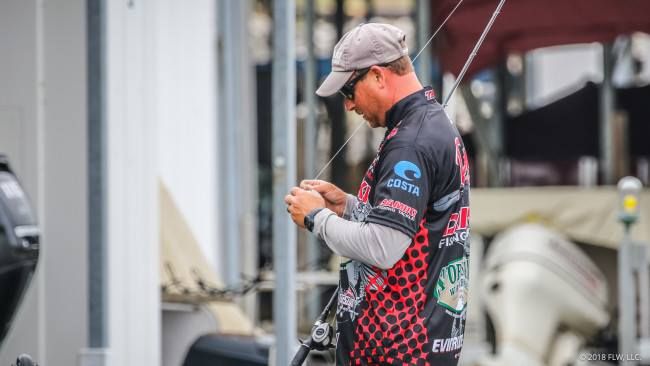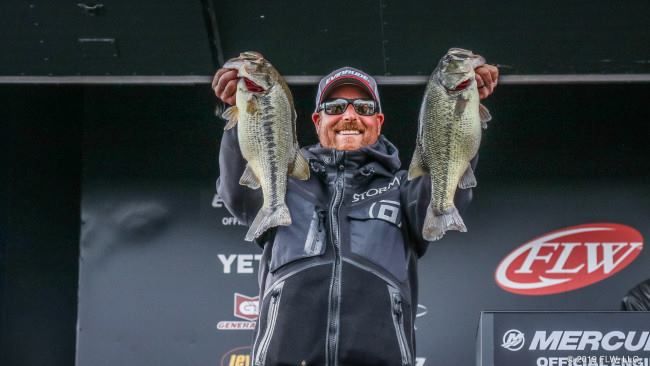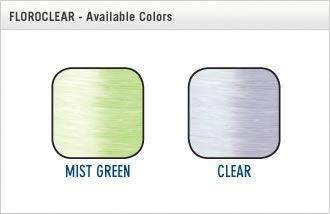When it comes to fishing line, generally, it is the big three: braid, fluorocarbon, and monofilament. But, there is another one out there, and it combines best the properties of two of those lines. P-Line’s Floroclear is their tough copolymer with a fluorocarbon coating.
FLW pro Bryan Thrift says there are countless benefits to this line, and for a few select techniques, it best line to use.
What is Floroclear?
In simple terms, it is a monofilament line coated with fluorocarbon. This does a few things, according to Thrift,
“It fishes like a fluorocarbon, but it has more stretch than standard fluorocarbon. At the same time, it doesn’t stretch as much as regular mono,” he began.
These properties bridge the gap between the two lines, and Thrift says it doesn’t just stop at the level of stretch. “You will also notice it has a lot less memory than other lines, and that is part of why it does so well on spinning gear. It casts great, lays tight on the spool, and the knot strength is great.”
Floroclear can be used for just about any technique, but Thrift said that when fishing shallow crankbaits or using extremely lightweight lures, it is the way to go.
Light Baits
When mentioning light lures, Thrift means very light baits like small poppers or weightless soft plastics.
“Floroclear does a great job at casting light baits on spinning gear, and I like to use 6 or 8-pound test when fishing small flukes, light plastics with an exposed hook, or for poppers like the Damiki D Pop for schooling fish. The line casts so free, and you can get longer casts to reach those schoolers,” he said.
Many anglers, including Thrift, have switched to a braid to fluorocarbon leader on most spinning applications. But still, he believes that Floroclear is a better choice for these light lures.
“It definitely casts better than braid when the lures are 1/8 ounce or less,” he believes.
READ RELATED: Jimmy Reese Selects Fishing Line for the Conditions
Shallow Cranking
Another time when Floroclear shines in when shallow cranking and using squarebills. Thrift likes it because it is a nice balance with the amount of stretch it has. He says it is in between that of monofilament and fluorocarbon, and that’s how he likes it.
“It is a nice happy medium between having a lot of stretch and very little stretch. Most times, when you are shallow cranking, you are going down the bank and hitting targets,” he said. “You usually get bit close to the boat with hardly any line out, and having a little more stretch from the Floroclear helps. You are less likely to pull those hooks out of the fish if you have a little more stretch than you do with regular fluorocarbon line.”
READ RELATED: 5 Proven Techniques for 2 Completely Different Types of Bass
Knots, Line Color, and Memory
One of the biggest positives for Floroclear is knot strength. “The knot strength is excellent. I use a Palomar knot for everything, and it ties and holds really well with Floroclear,” said Thrift.
This line is available in pound tests ranging from 2 to 30-pound test and in 300, 600, and 3000-yard spools. It also comes in both the Mist Green and Clear colors. For Thrift, he sticks with the Clear color in his favorite pound tests. “I know for some water clarities, the green is perfectly fine, but I always prefer not to be able to see my line when fishing for schooling fish,” Thrift added.
Besides the casting and knot strength, Thrift has been impressed with Floroclear for the reduced memory and for how long it lasts.
“It is a soft line, and that is what makes it so good on spinning reels. There is very little memory, and you don’t seem to get as much line twist,” he believes. “It is a soft line, and the best way to describe it is it is a fluorocarbon that acts like a mono on spinning gear.”
Another benefit, according to P-Line, is the abrasion resistance it offers. The process of making this line includes a special silicone treatment. Both of these characteristics, in real-world fishing terms, means extended life.
“It holds together well. I don’t have to change my line nearly as often with it. It is a long-lasting line.”
There are many choices for line type and just like rods, reels, and lures – the situation and conditions at hand are the deciding factors in choosing the perfect tool for the job. Bass fishing superstar Bryan Thrift uses them all and knows that it is essential to have the right line to match the technique to get the best results.






 Advertising
Advertising